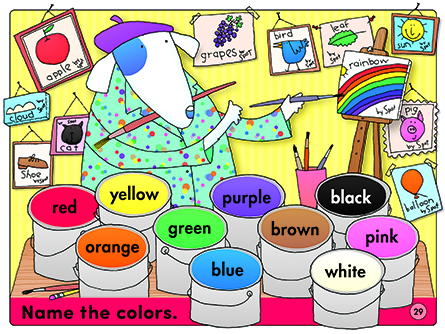Additional Activities
These activities offer options for continuing the learning in this unit. Whether your curriculum is skill-based or more open-ended, select the activities that are most appropriate for the children in your classroom. The Writing Spot is primarily a writing program, but writing can be integrated throughout your curriculum—in art, drama, reading, math, and science.
-
Make colorful butterfly puppets.
Share books about butterflies. Point out the ones that children might see in their own backyards. Talk about the colors of butterflies’ wings. Have children make their own "Butterfly Puppet." Make up poems about butterflies and play appropriate “butterfly” music as children make their butterflies flutter.
Teach a color game in which the leader holds up a color word, and the other players find and touch something of that color. Also, you could hold up a color word, and ask all students who are wearing that color to gather near you.
-
Carry out a color survey.
Post the color words on a wall or door and have children tape their name cards beneath their favorite colors. Check the results. Which color is the most popular? Least popular? This activity could be used in a lesson on bar graphs.
Provide narrow strips of various colored papers. Invite children to cut or tear the strips apart into small pieces, which are then glued onto art paper or cardboard to create mosaics. After they have finished their designs, ask children to name their designs and/or write a list of the colors they used in their artwork.
-
Read and enjoy color poems.
Make large copies of poems that are about colors. Post the poems and read them with the children. Have the children circle the color words with the appropriate marker or crayon.
-
Find out about mixing colors.
Show children paint samples from a local paint store. Talk about how all the various colors are made by adding other colors to white paint. The shade of each color (whether it is light or dark) depends on how much color is added to the white paint. Have children sort the paint samples into basic color groups. Look at the names on the samples and invite children to make up new names for some of the colors.
-
Invite an artist to class.
Ask a local artist to visit your classroom. Prepare your room by having the children create colorful artwork on a bulletin board. Make and hang colorful mobiles. Hang paper chains and crepe-paper streamers. Afterward, have the children make colorful collage thank-you cards to send to their guest.
-
Consider color changes in nature throughout the year.
As a class project, gather pictures to sort into seasons. Flower and bulb catalogs are great resources. Talk about the colors of the flowers and trees as well as the various animals and insects that you see during the spring, summer, winter, and fall. Collect colorful fall leaves. Discuss the winter colors and changes in your region. Have each child pick a season and write a story about the colors he or she might see on a walk during that time.
Ask children to name as many holidays as they can think of. Which holidays have special colors? There is red for Valentine’s Day; green for Saint Patrick’s Day; orange and black for Halloween; red, white, and blue for the Fourth of July; and so on. If you can, find out why these holidays are associated with specific colors. As a class, make up a new holiday. Pick a name and a special color, and make posters about this holiday. Finally, celebrate it with a classroom party.
Discuss what kinds of music fit with certain colors. Play recordings of music that seems to fit the emotions suggested by certain colors. Have the children pretend to be a color and dance to the music. Ask questions: How would bright colors dance? How would pale colors dance? How would black dance? Yellow? Blue? Children may want to write stories about their dancing colors after this activity.
-
Recognize the world’s rainbow of people.
Show pictures of people with varying skin, hair, and eye colors. Have children get into groups by eye color or hair color. Make name lists of those with blue eyes, brown eyes, green eyes, blonde hair, black hair, and so on. Say this poem together:
My friends are beautiful
In their own way.
Just like a rainbow,
They brighten my day.

